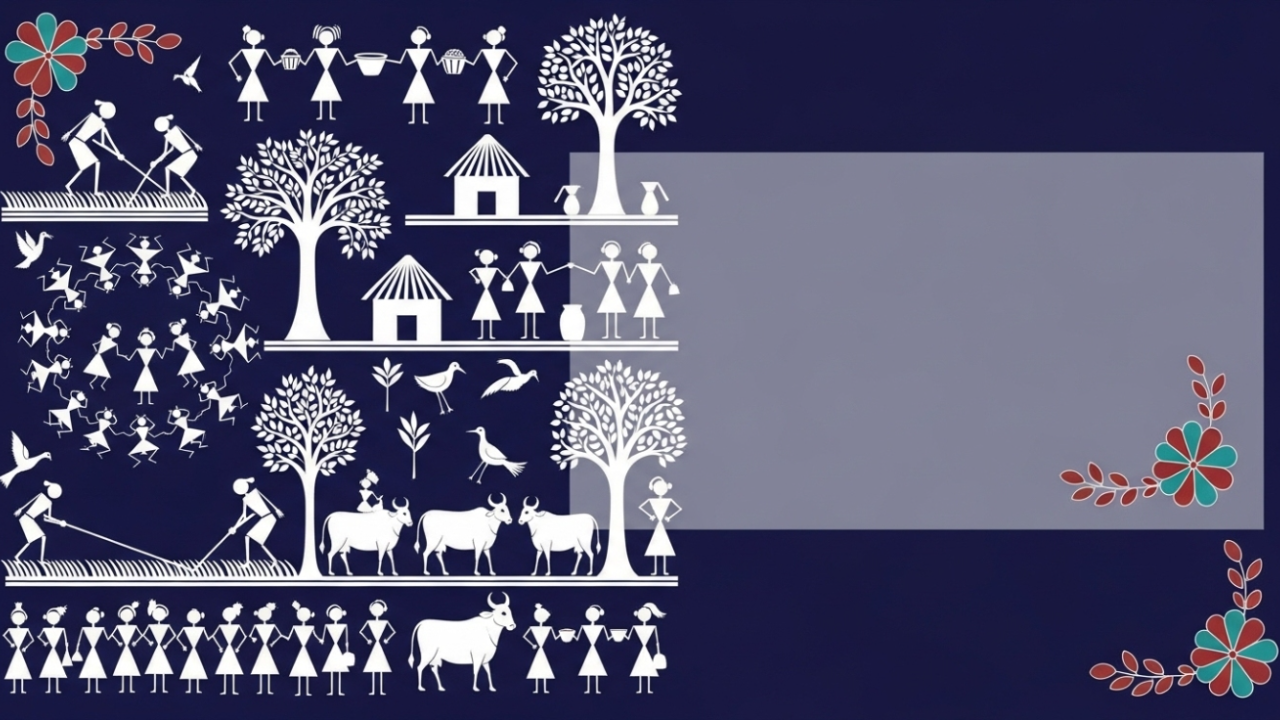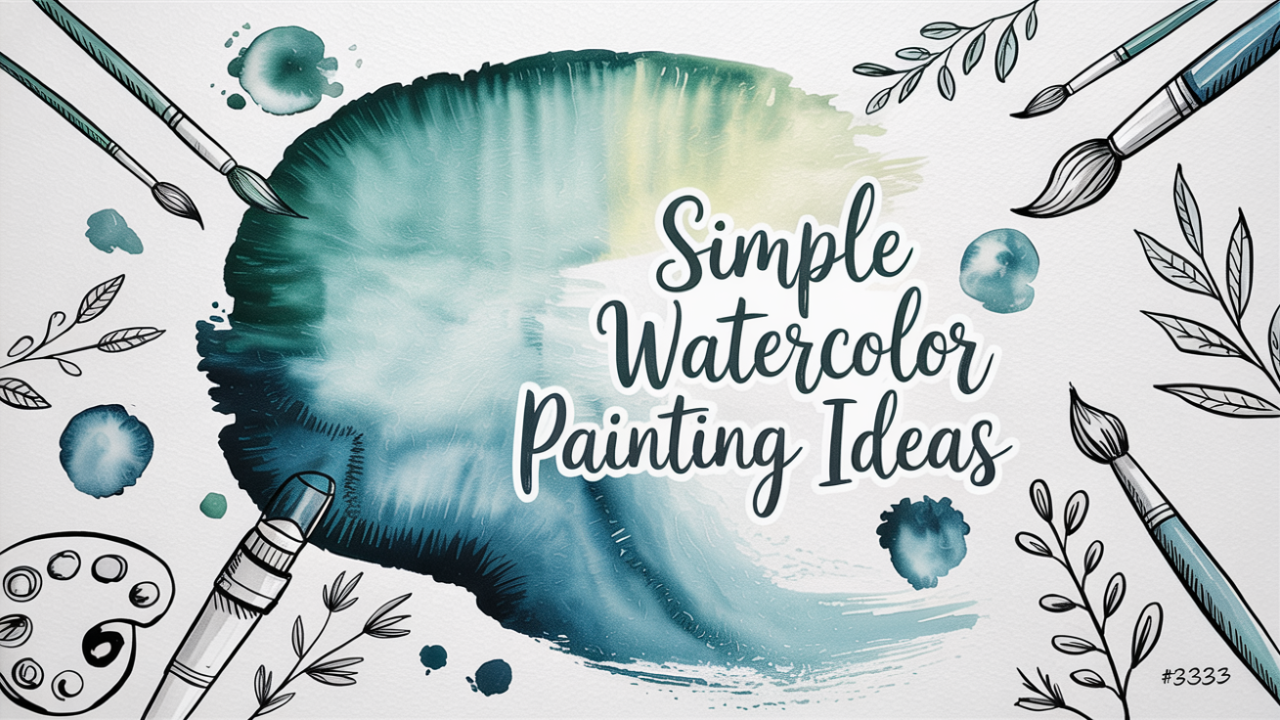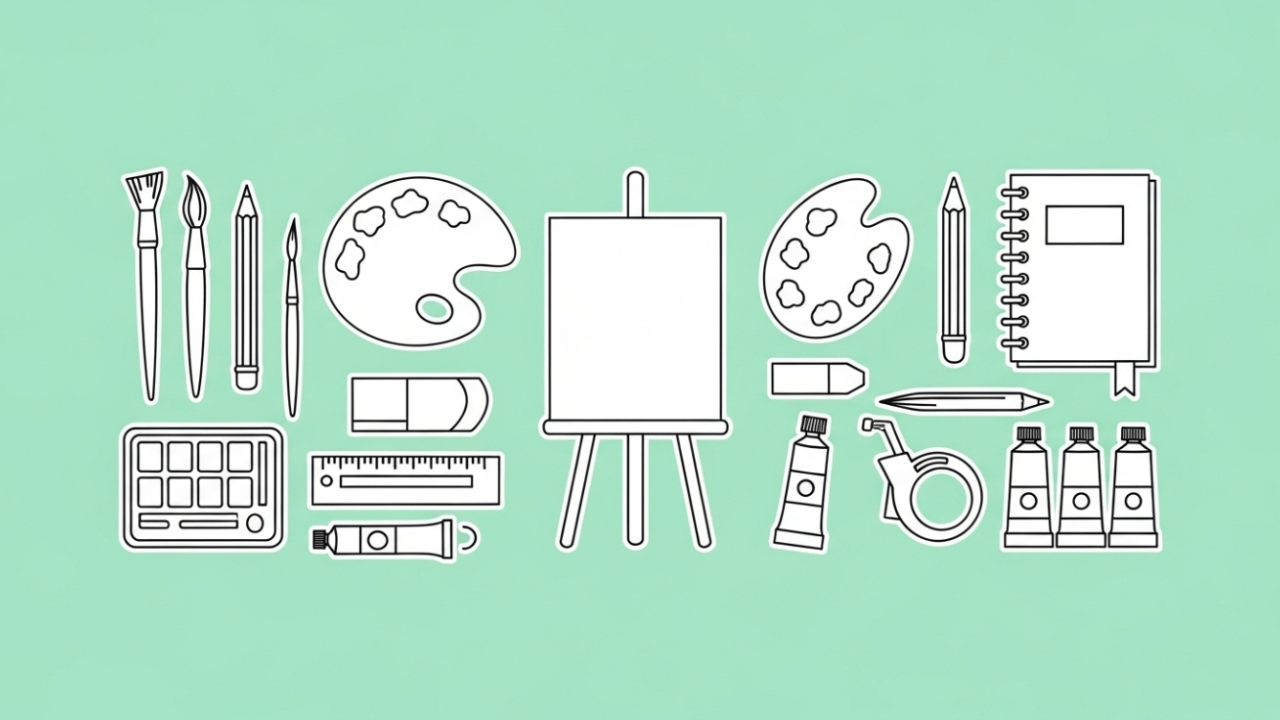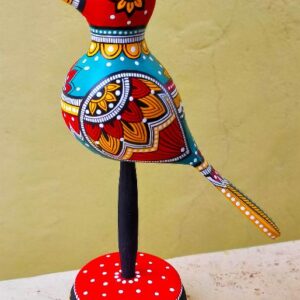
About the Author
Mohd Amaan
Mohd Amaan is an Artist, Writer & Creative Expert at Artisthu. He blends fine art with modern design and storytelling, helping creators present their work beautifully and effectively online.
Table of Contents
ToggleIntroduction to Indian Folk Art History
The history of Indian folk art is a rich tapestry that reflects the cultural soul, community traditions, and artistic expressions of India over thousands of years. Unlike classical art forms, which were often created for royal courts or religious elites, Indian folk art emerged from villages, towns, and small communities, making it a genuine expression of everyday life. Indian folk art paintings and Indian folk art drawings are not merely decorative; they are storytelling mediums, capturing beliefs, rituals, and daily activities of people from different regions.
Each art style is distinct, employing natural colors, symbolic motifs, and patterns inspired by nature, mythology, and social customs. From the intricate Madhubani paintings of Bihar to the minimalist geometric patterns of Warli from Maharashtra, the diversity of Indian folk art illustrates the creativity and cultural richness of the nation.
Scholars, students, and art enthusiasts explore Indian folk art history PDFs, books, and museum collections to study these traditions. Many people also attempt easy Indian folk art drawings at home to connect with this heritage. Today, Indian folk art history is celebrated globally, with exhibitions, workshops, and online platforms showcasing traditional Indian folk art prints and designs. This history is not just about art—it is a living testament to the beliefs, values, and creativity of ordinary communities across centuries.



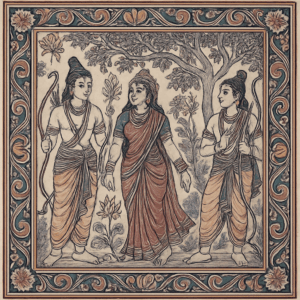
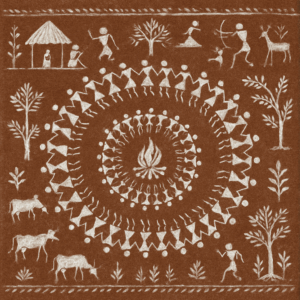
Origins and Early History of Indian Folk Art
The origins of Indian folk art history can be traced back to prehistoric times. Cave paintings found in Bhimbetka, Madhya Pradesh, dating back to the Stone Age, serve as the earliest evidence of artistic expression in India. These Indian folk art drawings depicted scenes from hunting, rituals, dancing, and daily life, illustrating that storytelling through art was central to human civilization even in ancient times. The use of natural pigments, simple tools, and symbolic representation in these early artworks laid the foundation for centuries of folk art traditions.
Over time, as communities settled and agriculture developed, folk art evolved to reflect not only survival and social life but also spiritual and religious beliefs. Art became an integral part of ceremonies, festivals, and communal events, preserving stories and practices that were passed orally from one generation to another. This phase of Indian folk art history established the key characteristics that define traditional Indian folk art today: communal creation, symbolic representation, and deep connection to daily life and nature.
Medieval Period in Indian Folk Art History
During the medieval period, Indian folk art flourished in regional contexts, often linked with religious and social practices. Unlike classical art forms that were commissioned by royalty or temples, folk art was produced by ordinary people for everyday use, festivals, and rituals. This era saw the formalization of several regional art forms that continue to influence Indian folk art today.
For instance, Madhubani paintings from Bihar developed unique geometric patterns, depicting gods, goddesses, and nature. These paintings were traditionally applied to walls and floors during weddings and festivals, combining decorative appeal with spiritual storytelling. Similarly, Pattachitra from Odisha and West Bengal used cloth or palm leaves to narrate epics like the Ramayana and Mahabharata, often featuring bold lines, vibrant colors, and intricate detailing. Kalamkari from Andhra Pradesh utilized pen-and-dye techniques to depict floral and mythological motifs, blending artistic expression with functional textiles.
In Maharashtra, Warli art emerged as a minimalist style using simple geometric shapes like circles, triangles, and lines to depict human figures, animals, and nature. These artworks, often painted on mud walls, symbolized harmony with the environment and community life. The medieval period, therefore, represents a crucial phase in Indian folk art history, where regional styles crystallized and folk traditions were closely tied to social, religious, and environmental contexts.
Colonial Period and Preservation
The colonial era brought significant challenges to traditional Indian folk art. Industrialization, new materials, and urbanization disrupted centuries-old practices. Many folk artists faced declining demand, as imported European art and industrial products became popular. Despite these pressures, several communities preserved their artistic traditions. Warli, Gond, and Madhubani art survived because local communities continued to practice these arts during festivals, weddings, and rituals.
During this period, researchers and scholars began documenting Indian folk art history in books, journals, and PDFs. Organizations like the Centre for Cultural Resources and Training (CCRT) played a key role in preserving knowledge about folk art styles, techniques, and themes. These efforts ensured that Indian folk art history would not be lost to industrialization and modernization and provided resources for future generations to learn and practice these art forms.
Modern Era and Global Recognition
In modern times, Indian folk art history has gained international recognition. Museums, galleries, and exhibitions showcase Indian folk art prints and original works, highlighting their aesthetic and cultural significance. Art festivals and workshops provide platforms for artisans to share their skills and preserve traditional techniques. Educational institutions now include Indian folk art history PDFs and projects in their curriculum, teaching students about the importance of folk art in understanding India’s cultural heritage.
Contemporary artists also draw inspiration from traditional forms, blending folk motifs with modern art, fashion, and design. This fusion ensures that Indian folk art history continues to evolve while maintaining a strong connection to its origins. The global appreciation of Indian folk art today underscores its enduring value, not just as an aesthetic pursuit but as a cultural and educational resource.
Types of Indian Folk Art
- Madhubani Painting
- Origin: Bihar
- Features: Intricate designs depicting mythological stories, gods, animals, and nature.
- Medium: Traditionally walls and floors; now paper, canvas, and textiles.
- Importance: A key part of Indian folk art history, representing cultural rituals and festivals.
- Warli Art
- Origin: Maharashtra
- Features: Minimalist geometric patterns using circles, triangles, and lines to depict humans, animals, and nature.
- Medium: Mud walls traditionally; now on paper and canvas.
- Importance: Essential for beginner-friendly Indian folk art drawings and learning.
- Gond Art
- Origin: Madhya Pradesh
- Features: Vibrant dots and lines forming complex patterns inspired by nature and mythology.
- Medium: Paper, walls, and everyday objects.
- Importance: Reflects centuries of cultural storytelling and community life.
- Pattachitra
- Origin: Odisha and West Bengal
- Features: Bold lines and bright colors, narrating epics like the Ramayana and Mahabharata.
- Medium: Cloth or palm leaves.
- Importance: Internationally recognized, a major style in Indian folk art history.
- Kalamkari
- Origin: Andhra Pradesh
- Features: Hand-painted or block-printed floral and mythological motifs using a pen (“kalam”).
- Medium: Fabrics, textiles.
- Importance: Blends traditional Indian folk art with modern utility.
- Phad Painting
- Origin: Rajasthan
- Features: Large scroll paintings depicting local deities and stories; used in storytelling performances.
- Medium: Cloth scrolls.
- Importance: Combines visual art with performance, preserving historical narratives.
- Other Regional Arts
- Saura Painting (Odisha): Religious motifs similar to Warli.
- Cheriyal Scrolls (Telangana): Bold-colored narrative scrolls.
- Kalighat Painting (West Bengal): Temple-inspired deity paintings.
- Tanjore Painting (Tamil Nadu): Gold leaf and gem-studded divine images.
Characteristics and Themes in Indian Folk Art History
A key characteristic of Indian folk art history is its storytelling tradition, with artworks narrating epics, legends, and festivals. Symbolism is also significant; animals, trees, and celestial bodies often represent deeper spiritual or cultural meanings. Artists use natural materials such as mud, natural dyes, and handmade brushes. Community practice is central—folk art is often created collectively during ceremonies and celebrations, making it accessible to ordinary people and strengthening social bonds.
Common themes in Indian folk art include nature and wildlife, mythology, festivals, daily life, and folk tales. These recurring motifs help preserve cultural memory and make folk art a window into the lives and beliefs of past generations.
Learning and Practicing Indian Folk Art History
For beginners and enthusiasts, learning Indian folk art can be both creative and educational. Books like Indian Folk Art by Subodh Chandra provide detailed historical context. Free PDF guides like Living Traditions: Tribal and Folk Paintings of India offer practical instructions for creating Madhubani, Warli, Gond, and other artworks. Workshops and cultural centers provide hands-on training from traditional artisans, allowing learners to connect directly with folk traditions. Simple drawings, starting with Warli stick figures or Gond dots and lines, are ideal for understanding techniques and motifs. Collecting folk art prints also helps preserve the tradition while decorating homes or workspaces.
Learning and practicing Indian folk art not only nurtures creativity but also contributes to the preservation of India’s rich cultural heritage.
Importance of Indian Folk Art in Modern Times
Despite centuries of change, Indian folk art history remains relevant. It preserves cultural traditions and ensures that community stories and rituals continue to be shared. Many artisans rely on the sale of paintings, prints, and handicrafts for their livelihood. Using natural materials, folk art promotes sustainable and eco-friendly practices. Furthermore, incorporating folk art into education through PDFs, books, and workshops helps future generations appreciate India’s cultural diversity. Global exhibitions and collaborations highlight the universal appeal of Indian folk art, making it an important part of both cultural preservation and creative innovation.
FAQs about Indian Folk Art History
- What is Indian Folk Art History?
It is the study and documentation of how folk art in India evolved over centuries, including regional styles, materials, themes, and community practices. - Which are the most famous Indian folk art types?
Madhubani, Warli, Gond, Pattachitra, Kalamkari, Phad, Saura, Cheriyal, and Tanjore. - How did Indian folk art develop historically?
From prehistoric cave paintings to medieval regional styles, folk art evolved with social, religious, and environmental contexts. - Why is Indian folk art history important today?
It preserves cultural identity, supports artisans, promotes eco-friendly practices, and educates younger generations. - How can beginners practice Indian folk art?
Start with simple Warli or Gond drawings, attend workshops, read books, and explore Indian folk art PDFs for guidance.
Conclusion
The history of Indian folk art is a living testament to India’s creativity, culture, and community traditions. From Warli and Madhubani to Pattachitra, Kalamkari, and regional styles, every artwork tells a story of faith, daily life, and social values. Exploring Indian folk art history through books, PDFs, workshops, or practicing drawings allows us to connect with centuries of tradition. By learning, sharing, and preserving these arts, we ensure that the legacy of Indian folk art history continues to inspire and educate future generations.

Written by: Mohd Amaan


